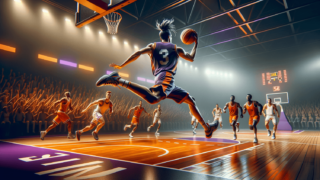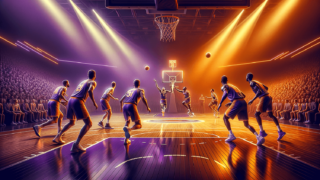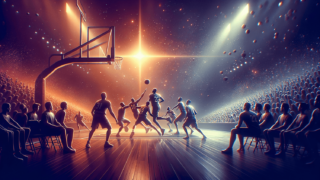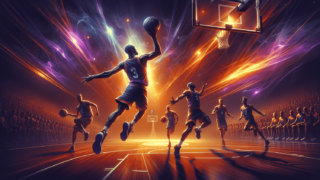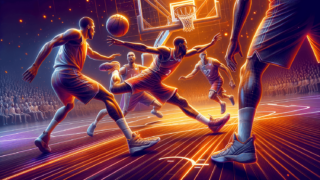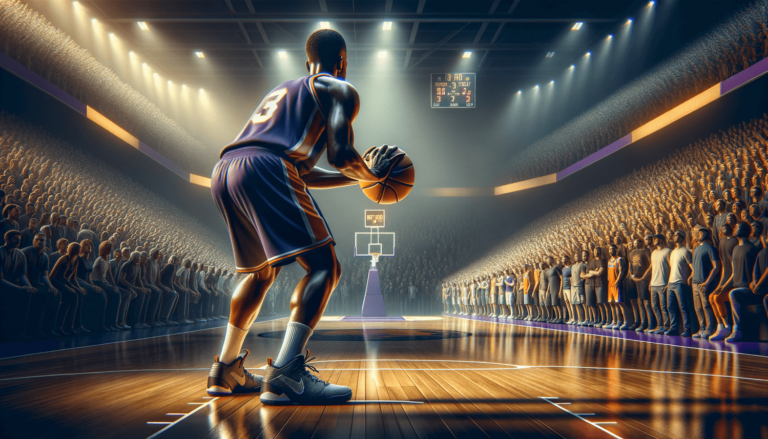
Ten-Second Free Throw Rule in Basketball
Written by: Basketball Universe
Last updated:

If you’re a basketball enthusiast with a thirst for knowledge, then you’ve found yourself in the perfect place! Get ready to dive into the exciting world of the Ten-Second Free Throw Rule in Basketball, a seemingly simple rule that carries greater significance than many realize. This essential regulation helps maintain the pace and rhythm in a basketball game while demanding both mental and physical focus from the players. Stick around, as we break down the ins and outs of this intriguing rule, uncover its history and reveal the strategic importance it holds in the mesmerizing game of basketball.
Ten-Second Free Throw Rule in Basketball
The Ten-Second Free Throw Rule in Basketball is a regulation that requires a player to complete their free throw attempt within ten seconds from the moment they receive the ball from the referee. If the player fails to release the ball within this time frame, the attempt is considered a violation, resulting in a loss of the free throw attempt, and the opposing team is awarded possession of the ball.
History of the Ten-Second Free Throw Rule
Understanding the roots of a rule can provide valuable context when discussing its implementation and impact on the game. The ten-second free throw rule in basketball traces its origins back to the early evolution of the sport. Initially, there were no time constraints on free throws, leading to players taking an excessive amount of time to perfect their shot or even employ stalling tactics. To counter this inefficiency and uphold the dynamic and fast-paced nature of the game, the ten-second free throw rule was instituted in the FIBA competitions in 1956 and later adopted by the NCAA and NBA.
Mastering the Ten-Second Countdown
Staying Focused Under Pressure
One of the most crucial elements in complying with the ten-second rule is maintaining focus under pressure. Basketball is a high-stress game, and the ability to stay calm and collected during free throw attempts can drastically influence a player’s performance. Developing a consistent pre-shot routine helps reduce anxiety and keeps players concentrated on the task at hand. For example, taking a few deep breaths, dribbling a predetermined number of times, and visualizing a successful shot can help establish consistency and boost confidence on the free throw line.
Perfecting the Shot Mechanics
The execution of a proper free throw shooting technique has its foundation in mastering the correct mechanics. By incorporating a solid base, proper hand placement, and a smooth follow-through, players can increase the likelihood of their shot finding the basket in a timely fashion. Practicing these steps with the ten-second constraint in mind will help create muscle memory, ensuring that the process becomes second nature come game time. Remember, practice makes perfect, and continually refining the shot mechanics will pay dividends when fighting against the clock.
Strategy and Tactics Surrounding the Ten-Second Rule
Using Free Throw Attempts as a Breather
While the ten-second rule in basketball prevents players from using free throws as prolonged breaks, there’s still time to gather oneself and re-energize. During a high-intensity game, every second of rest counts. As fatigue sets in, both physical and mental acuity can diminish. Utilizing free throw attempts to take a brief pause, recuperate, and refocus can have a substantial impact on a player’s performance throughout the match.
Disrupting Opponent Focus
Although the ten-second rule demands players maintain their focus, opposing teams can employ tactics to disrupt the shooter’s concentration. A little gamesmanship never hurt anyone, right? Some players may resort to slick moves such as intentionally bumping into the shooter or taunting them. However, it’s essential to toe the line between strategic and unsportsmanlike conduct. Knowing your limits and respecting the spirit of the game is crucial when engaging in such tactics.
Consequences of Violating the Ten-Second Rule
Breaking the rules can always result in negative consequences, and the ten-second free throw rule is no exception. Violating the rule can lead to the following outcomes:
- Loss of Free Throw Attempt: As soon as the ten-second limit is passed, the shooter loses the opportunity to make their free throw. This can be a costly missed opportunity, particularly in tight contests where every point counts.
- Possession Transfer: In addition to forfeiting the free throw attempt, the offending team also loses possession of the ball to the opposing team. This gives the opposition a chance to capitalize on the mistake and potentially score points at the other end of the court.
Notable Instances of the Ten-Second Free Throw Violation
While the ten-second free throw rule may seem straightforward, it has caught several high-profile players off guard in crucial or high-stakes situations. These notable violations serve as excellent examples of the rule’s significance in the game of basketball:
- Dwight Howard: As one of the most dominant centers in the NBA during his prime, Dwight Howard was no stranger to the free throw line. However, he struggled with his free throw shooting throughout his career, often taking excessive time to set up his shot. In a 2013 game against the Charlotte Bobcats, Howard was called for a ten-second violation in the closing minutes of a close contest, which garnered significant attention.
- Karl-Anthony Towns: In a 2017 game against the Philadelphia 76ers, Minnesota Timberwolves star Karl-Anthony Towns was whistled for a ten-second free throw violation. This incident highlighted the importance of staying cognizant of the countdown, even when dealing with the on-court distractions and pressure.
Impact of the Ten-Second Rule on Basketball Rules as a Whole
When analyzing the broader context of the ten-second free throw rule, it becomes clear that this regulation plays a vital role in upholding the spirit and pace of the game. The rule exemplifies the emphasis on strategy, focus, and efficiency that permeates basketball rules as a whole. By demanding concentration and composure during free throw attempts, the ten-second rule reinforces the notion that every single moment on the court should be treated with the utmost importance.
A Final Word: Basketball Rules and Beyond
Exploring the ten-second free throw rule provides enthusiasts and aspiring players with vital insights into the intricacies and nuances of basketball. From understanding the rule’s history and mastering its requirements to delving into the realm of strategy and tactics, appreciating the importance of this seemingly simple regulation is key to grasping the thrilling and captivating nature of basketball. With the knowledge in hand, you’ll be better equipped to appreciate the finer details of this beloved sport and elevate your game to new heights!
Improving Free Throw Performance under the Ten-Second Rule
Now that we’ve covered the essentials of the Ten-Second Free Throw Rule in Basketball, let’s explore some practical tips and training routines to help players make the most of their free throw opportunities under the constraints of the rule.
Establish a Pre-Shot Routine
Develop a pre-shot routine that you can execute in under ten seconds. This routine may include a set number of dribbles, deep breaths, or self-talk. Consistent practice of this routine will help you feel more comfortable and confident during your free throw attempts, ultimately saving precious seconds.
Embrace Pressure Situations in Training
Simulate high-pressure game situations during practice sessions to become accustomed to performing under stress. Free throw shooting competitions or exercises that count down from ten can help simulate the game environment and encourage you to hone your skill and concentration under pressure.
Utilize Mental Rehearsal Techniques
Mental rehearsal, or visualization, is the practice of imagining yourself performing an action or skill before physically executing it. By mentally rehearsing free throw attempts within the ten-second time frame, you can train your mind to operate under the constraint and reduce the chances of committing a ten-second violation in a game.
Focus on Building Endurance
Increasing your overall endurance will help prevent late-game fatigue, which may affect your free throw performance. Engage in regular cardiovascular workouts, strength training, and interval training to improve your stamina, enabling you to perform at your best even in the final moments of a game.
Concluding Remarks: Mastering the Ten-Second Free Throw Rule
The Ten-Second Free Throw Rule in Basketball serves to maintain the pace of the game and ensure fair gameplay. Mastering the intricacies of this rule requires dedication, practice, mental focus, and strategic thinking. By embracing the tips and techniques outlined in this comprehensive guide, players can maximize their potential and become experts at handling the pressure of the ten-second countdown during critical game situations.
FAQ: Ten-Second Free Throw Rule in Basketball
To address any lingering queries or uncertainties about the Ten-Second Free Throw Rule in Basketball, we have compiled a list of the most frequently asked questions on the topic. Discover answers to common questions and gain an even deeper understanding of the rule’s intricacies and effects on the game.
1. When does the ten-second countdown start?
The ten-second countdown begins the moment the shooter receives the ball from the referee at the free throw line.
2. How does the referee indicate a ten-second violation?
The referee will blow their whistle and signal the violation using a specific hand gesture, crossing their wrists with open palms facing outwards.
3. Can a player shoot a free throw before the ten-second countdown is up?
Yes, a player is allowed to shoot the free throw as soon as they receive the ball from the referee, as long as it is within the ten-second window.
4. What happens if there is a distraction outside the player’s control during the ten-second window?
In the event of an external distraction or interruption, such as a fan blowing a whistle or the scoreboard malfunctioning, the referee has the discretion to either stop the countdown or ignore the disturbance and continue with play.
5. What is the purpose of the ten-second free throw rule?
The primary purpose of the rule is to maintain the flow and pace of the game by preventing players from employing stalling tactics or taking excessive time to shoot their free throw.
6. Does the ten-second rule apply at all levels of competition?
Yes, the Ten-Second Free Throw Rule in Basketball is widely implemented across various levels of competition, including FIBA, the NCAA, and the NBA.
7. Can opposing players talk to the shooter during the ten-second countdown?
While “trash talking” is a common aspect of the game, players must be respectful and adhere to sportsmanship guidelines. Excessive taunting, insults, or unsportsmanlike behavior can result in a technical foul being assessed against the opposing player.
8. How can I practice my free throw shooting with the ten-second rule in mind?
Practice your pre-shot routine, improve your shot mechanics, and simulate high-pressure situations during your training sessions. Incorporate a timer or countdown into your drills to simulate the ten-second constraint.
9. Is there a similar rule for other types of shots in basketball?
The Ten-Second Free Throw Rule is specific to free throws, but there are other timing constraints in basketball, such as the 24-second shot clock, which limits the amount of time an offensive team can possess the ball before attempting a field goal.
10. Does the same ten-second rule apply in wheelchair basketball?
Yes, the Ten-Second Free Throw Rule applies to wheelchair basketball as well, ensuring fair and consistent gameplay across various basketball disciplines and levels of competition.
Featured Posts
- No pillar pages found.
